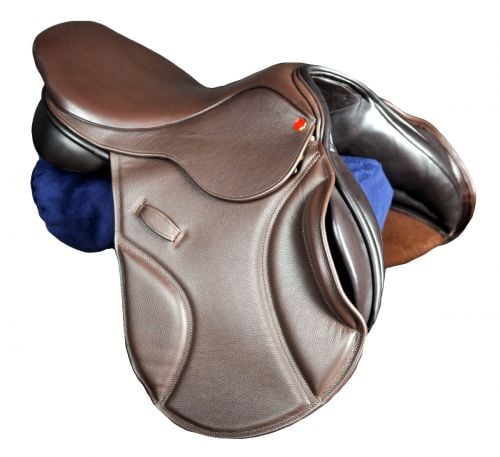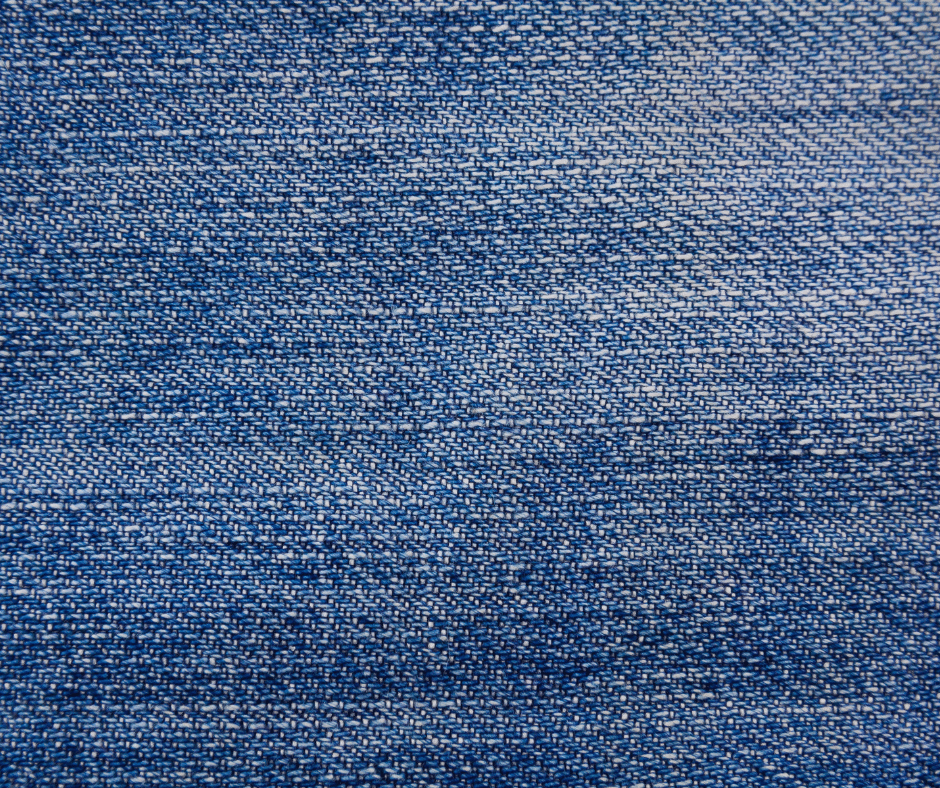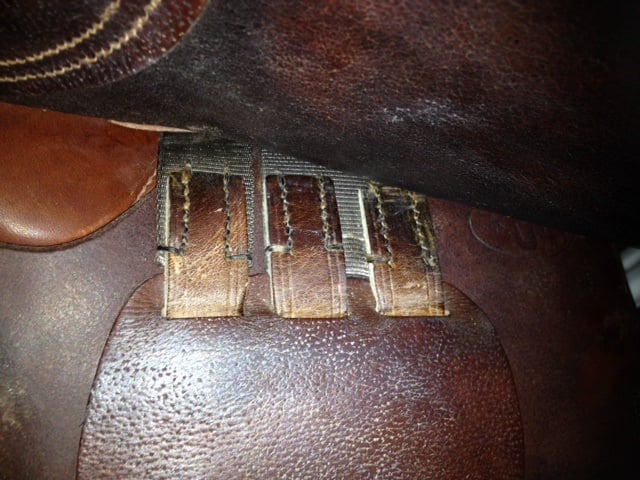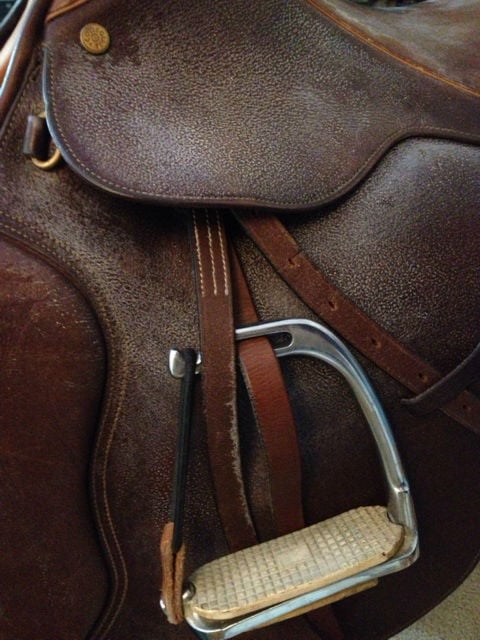Discover the Best Way to Clean a Saddle
We spoke with Amanda Braun, an avid rider and professional photographer in Boyds, MD, who didn’t know the best way to clean a saddle. After purchasing her brand new saddle, she very quickly had a mold problem on her hands.
Despite regular cleaning, each day she walks into the tack room to a fluffy white mold covering the underside of her saddle flaps. This is upsetting to her after spending a great deal of money and time to find the perfect saddle for her tall lean frame and young Holsteiner gelding. In this article, we are going to take an in-depth look at the best way to clean a saddle and see if we can unlock the mysteries of her moldy dilemma.
Saddles can cost anywhere from several hundred to a few thousand dollars, and they are vitally important. According to saddle expert Annette Gavin of Hastilow Competition Saddles USA, “Neglected saddlery can significantly worsen the performance of our horses and of our riding, it is also a danger if it fails.”
With learning the best way to clean a saddle, this piece of equestrian equipment can serve you well for many years.
Photo Credit: Amanda Braun - Catchlight Artistry
First Things First: An Introduction to Leather Saddles
Animal hides are preserved through a process called tanning, where a vegetable (tannin) is applied. Hastilow, which uses only the best English leathers, uses vegetable tanned leather because it is softer and more pliable. It is also easier to work.
In addition, this type of leather does not contain some of the harmful chemicals used in chrome tanning.
The leather on your saddle can be made from a variety of animal hides ranging from mature cattle, does, calves, and even alligator. “Leather is a natural product. It breathes, sweats, dries, and is impacted upon by its surroundings,” explained Annette. “The method of tanning, the resultant quality, and the care it receives determines how long a life it has and how good a value for money it is.”
Suede leather has lately been replaced by nubuck leather, which has a nap to provide grip. This material is made from the flesh side of leather and is best cared for by using 120-grit sandpaper to roughen the surface and maintain the nap. Without regular sanding, the nubuck will wear smooth over time.
The seat of your saddle is often made of softer leather, like doeskin or calf leather, that can stretch over the saddle frame. Annette explained that there are different thicknesses of calf leather depending on the age of the animal. “French leather is lovely to touch but is not wear resistant so these seats need to be replaced frequently,” explained Annette speaking of the thinner French leathers.
Annette explained that the best leathers come from Europe and colder places where the animals have a layer of body fat under their skin. Other leathers come from places like Argentina and India. “Argentine and Indian leather tends to be less dense and drier with a fibrous look to its flesh side,” Annette shared. “This makes these leathers more likely to stretch and crack as they have less tensile strength and they can break.”
What is the Best Way to Clean a Saddle?
Annette explained that most people encounter problems with their saddles because they are “quick cleaners” who don’t take the time to properly care for their equipment.
For instance, she cautioned against using “2-in-1” products that include cleaners and conditioners in one product. These products end up doing an inadequate job of both, clog the leather’s pores, and results in a gummy surface.
Here are Annette’s quick tips on how to best clean your saddle:
Step 1: Clean off dust, sweat, and other grime with warm water.
The best product to use to clean your saddle is easy to find – warm water! Annette explained that it can remove 90% of the dirt. “Don’t soak the leather!” she cautioned. Instead, use a slightly damp sponge to remove any dirt, sweat, and grime. Sometimes clumps of pulled horse mane can be used as an abrasive to scrub off the hard-to-remove dirt. You may need to use quite a bit of elbow grease on this step!
Step 2: Let it dry.
It is never good if moisture is trapped inside the pores of your leather. Remember - leather is skin. It has pores that can become clogged and the leather needs to be able to breathe. Be sure to allow your saddle to dry thoroughly before treating it with oil or other leather conditioners.
Step 3: Apply oil.
A light oil can be applied once every one or two months depending on the dryness of your saddle. Never over-oil your saddle because it can actually begin to separate the leather strands and weaken the material.
Step 4: Condition your saddle.
“A beeswax finish would be great” to finish off your saddle. Another finishing product would be glycerin saddle soap. This helps make the leather supple and seals the pores of the leather. Many people are under the false impression that saddle soap is used to clean leather. In fact, it should only be used after the dirt and grime have been removed. Otherwise, you are sealing in the pores while they are still filled with dirt. Once buffed with glycerin soap, “that leather will be so soft and so clean, it’s unbelievable,” declared Annette.
Step 5: Check the stitching and overall state of your saddle.
Check over the saddle stitching especially on the billets and top of the stirrup leathers to check for frayed strands. If your saddle is older, you should consider whether the interior tacks and webbing are in good shape and free of rust. Consult a saddle expert for this.
Basic Saddle Care Tip #1: Don’t Wear Denim Jeans to Ride
Since the seat leather on your saddle tends to be a bit thinner and more fragile, it is important to never wear jeans while riding in an English saddle. The seams on the seat of your denim jeans will wear the seat faster. If you are intent on wearing your favorite Levi’s to ride, at least invest in a seat protector to help maintain your saddle.
Those riding in Western saddles are okay to wear jeans because Western saddles are often made using chrome tanned leather that has been rolled more to produce sturdier leather.
Basic Saddle Care Tip #2: Check Your Stitching Regularly
Depending on the age of your saddle, you should be cautious of what oils you use. Older saddles were made with waxed cotton stitching with a bright white color. Saddle makers even used to wear white gloves while making the saddle to maintain the threads’ clean appearance. Some oils have been known to rot this stitching.
Newer saddles are made with a polyblend stitching that is stronger and more resistant to oils. It is, however, very important to regularly check the stitching on your billets and the top of your stirrup leathers. Even polyblend threads can become unraveled over time greatly increasing the chance of your saddle failing during a ride.
Basic Care Tip #3: Prevent Mold With Dry Storage and Correct Cleaning Practices
For any saddle owner, mold is “Public Enemy #1.”
Annette explained, “Things grow mold in high humidity when there is a lot of dampness in the air.” The best way to combat this menace is to store your saddle in a tack room with a dehumidifier for summer months to limit its exposure to moisture. Annette also recommends using a leather restorer/conditioner that has a mold inhibitor and spore killer included to battle mold when it rears its ugly face.
Be aware that mold spores often hide in the stitching of your saddle and can easily spread to nearby saddles in the same storage area. Eventually, mold grows inside your saddle just waiting for the perfect time to bloom again on the surface. By learning the best way to clean a saddle, you can ensure that you don’t seal mold into your leather. This will allow your leather to breathe so you can prevent mold growth.
Bonus Tip:
SafeTack horse trailers from Double D Trailers are a great way to protect your tack while on the road. Check out more horse trailers for sale.
Remember Amanda Who Didn’t Know the Best Way to Clean a Saddle?
Let’s go back to Amanda’s mold dilemma to see how she fared in the end. Her saddle had calfskin knee blocks that were filled with foam. Foam knee blocks are perfect reservoirs for mold spores to grow allowing them to regrow on the surface of her saddle night after night. The oil she was faithfully applying was trapping in the moisture preventing the leather from breathing properly. To fix this problem, she should continue to clean her saddle with a damp sponge, let it thoroughly dry, and limit the oiling on the calfskin. Eventually, Amanda was able to conquer her mold problem.
To learn more about saddle care, check out the Hastilow Competition Saddle USA website.
Also, check out Catchlight Artistry to see some of Amanda’s beautiful horse photography. Hopefully these tips on the best way to clean a saddle will help you care for your saddle so you can use it for many years to come!







